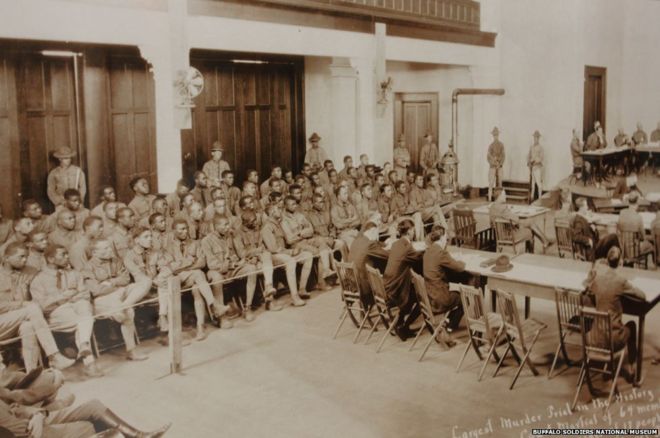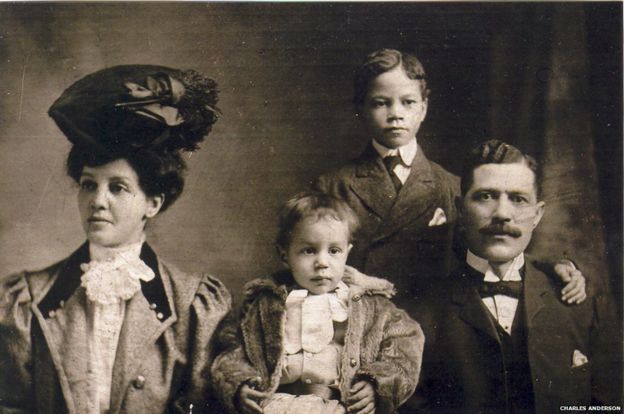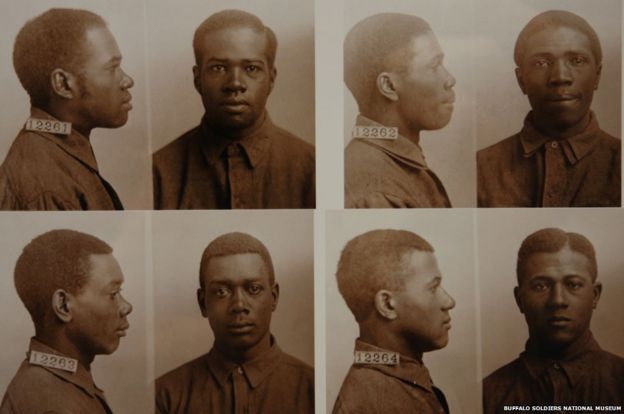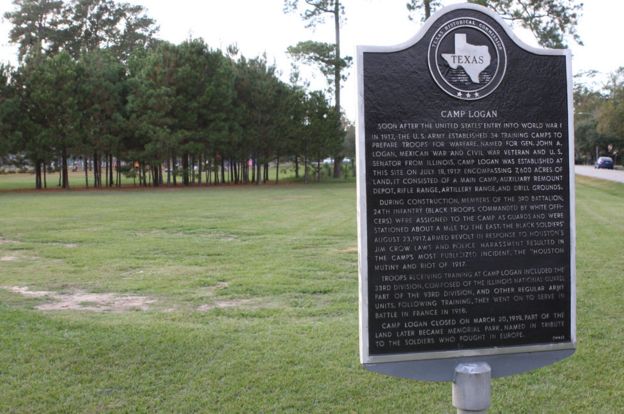http://www.bbc.co.uk/news/world-us-canada-42116688
A 100-year-old US riot only now being talked about
 Image copyright Buffalo Soldiers National Museum
Image copyright Buffalo Soldiers National Museum It’s almost 100 years since 19 African-American soldiers were executed following a violent mutiny in Texas. Why is the US only now coming to terms with what happened?
For decades, no name appeared above the grave of Corporal Jesse Moore, only the number seven.
The figure corresponded to noose number seven which was used to hang him and another 12 African-American soldiers beside the Salado Creek of San Antonio in December 1917.
The executions followed the rainy August night when more than 100 armed soldiers marched into the city of Houston and during a two-hour riot killed 16 whites, including five policemen.
The resulting court martial staged in three parts was the largest in US military history.
A total of 118 enlisted black soldiers were indicted, with 110 found guilty, 19 hanged and 63 receiving life sentences.
“They were denied due process guaranteed by the Constitution and died horrible deaths,” says Angela Holder, Moore’s great-niece and a history professor at Houston Community College.
“They were represented by one lawyer and didn’t even have a chance to appeal.”
In the spring of 1917, Moore and his unit, the 3rd Battalion of the predominantly black 24th United States Infantry had been dispatched to Houston to guard the construction site of a new camp following the United States declaring war on Germany.
“They sent these soldiers into the most hostile environment imaginable,” says Charles Anderson, a relative of Sergeant William Nesbit, another of the hanged soldiers.
“There was Jim Crow law [which denied black people equal rights], racist cops, racist civilians, laws against them being treated fairly in the streetcars, while the workers building the camp hated [the soldiers’] presence.”
 Image copyright Charles Anderson
Image copyright Charles Anderson Tensions continued to grow during the troops’ time guarding Camp Logan until the Houston police arrested a black soldier for interfering with the arrest of a black woman.
When one of the battalion’s military police went to inquire about the arrested soldier, an argument ensued, resulting in the military policeman fleeing the police station amid shots, before being arrested too.
Although he was later released, a rumour reached Camp Logan that he had been killed, coupled with talk of a white mob approaching the camp – there was none – resulting in soldiers grabbing rifles and heading into downtown Houston.
“It was dark and there was a big rain storm during the riot,” says Jason Holt, nephew of Private Thomas Hawkins who was hanged. “At the trial not one civilian could identify a soldier firing shots that killed people.”
Seven mutineers agreed to testify against the others in exchange for clemency.
Mr Holt has a 100-year-old letter written by Private Hawkins to his mother the night before his execution, telling her not to be upset about him taking his “seat in heaven”, and of his innocence.
Letter by Private Hawkins, dated 11 December, 1917
Courtesy of Jason Holt
Dear Mother & Father,
When this letter reaches you I will be beyond the veil of sorrow I will be in heaven with the angels. Mother don’t worry over your son because it is heavens gain look not upon my body as one that must fill a watery grave but one that is asleep it in Jesus. [sic]
I fear not death. Did not Jesus ask death ‘Where art thy sting’ Don’t regret my seat in heaven by mourning over me. I now can imagine seeing my dear Grandmother and Grandfather and the dear girl Miss Bessie Henderson that I once love in this world standing at the river of Jordan beckoning to me to come and O! Mother should they be sensitive of my coming don’t you think that they are anxious for tomorrow morning to come when I will come unto them.
I am sentence to be hanged for the trouble that happen in Houston Texas altho I am not guilty of the crime that I am accused of but Mother it is God’s will that I go now and in this way and Mother I am going to look for you and the family if possible I will meet you at the river. Come unto me all ye that are heavy laden and I will give the rest, Bless his holy name. This is the happiest day I met with since Jesus spoke peace to my soul in Brookstone church from my promise to God I have strayed away but I am with him now.
Send Mr Harris a copy of this letter. I am your son, TC Hawkins, Fort Sam Houston, Tex
PS. Show this to Reverend Shaw – Reverend Shaw, I am with Jesus and I will look for you in that great morning
“The men did not have a fair trial,” says Sandra Hajtman, a lawyer and great-granddaughter of one of the policemen killed. “I have no doubt about the likelihood the men executed had nothing to do with the deaths.”
Soon after the executions, the US Army changed its uniform code of military justice to prevent executions without a meaningful appeal.
“The soldiers were 100% wrong for rioting, but I don’t blame them,” says Jules James, the great-nephew of Captain Bartlett James, one of the battalion’s white officers who managed to restrain a larger number of soldiers from leaving camp.
“The unit had 60 years of excellent service, was full of experienced veterans but couldn’t endure seven weeks of Houston.”
 Image copyright Buffalo Soldiers National Museum
Image copyright Buffalo Soldiers National Museum A majority of the soldiers were raised in the South and familiar with segregation. But as army servicemen they expected fair treatment.
Houston police and public officials, however, viewed the presence of the black soldiers as a threat to racial harmony.
Many Houstonians were concerned that if the black soldiers were shown the same respects as white soldiers, black residents might come to expect similar treatment.
“This was a problem created by community policing in a hostile environment,” says Paul Matthews, founder of Houston’s Buffalo Soldiers National Museum, which examines the role of African-American soldiers during US military history.
“It’s up to people now to decide whether there are lessons relevant to the present.”
In Houston, knowledge about the riot varies – a rapidly growing city, most newcomers know nothing about an event that is rarely discussed.
“The business community, just as in other American cities with a story of racial trouble, preferred that it be forgotten – it’s not the sort of thing that builds tourism, after all,” says Mike Vance with the Heritage Society of Houston.
“But I most strongly disagree with any notion there was a decided attempt to not talk about it or any citywide memory lapse about it.”
 Image copyright Angela Holder
Image copyright Angela Holder The city leaders might not trumpet it, but it remains part of the collective memory of the population, Mr Vance explains.
“I think that is true of things as recent as the race riots of the 1960s in places like Detroit and Philadelphia and even the Rodney King riots in LA.”
Despite the tragedy, relatives of the soldiers recall growing up hearing their fates discussed by families, noting there was no shame attached.
“What happened at Camp Logan is a complex narrative to navigate,” says Lila Rakoczy, programme co-ordinator of military sites and oral history programmes at the Texas Historical Commission.
“There was no public acknowledgment of it for a long time, but now there is more willingness to talk about it.”
The centennial of US entry into World War One has probably brought a heightened awareness of such events and emboldened people to address a sensitive subject, Ms Rakoczy notes.
 Image copyright James Jeffrey
Image copyright James Jeffrey This year Ms Holder helped lobby for gravestones from the Veterans Association for unmarked graves in a Houston cemetery of two soldiers killed during the riot. She says she also wants to obtain posthumous pardons for the hanged soldiers.
“We tried during the Obama presidency and were on the list but missed out,” she says. “Perhaps we can approach a Texas politician or the National Association for the Advancement of Colored People [NAACP] to help.”
Moore and those executed with him only received headstones after authorities became concerned that flood waters from the creek might unearth the bodies. So the executed soldiers were re-interred in San Antonio’s Fort Sam Houston cemetery in 1937, says Ms Holder.
Meanwhile, as the 100th anniversary of the day of execution approaches, other relatives are left wondering what might have been if their relatives had gone to Europe with the other 350,000-plus African-Americans who served in WW1.
“Instead of a noose around my ancestor’s neck they may have been hanging a medal,” Mr Anderson says.
“The military should never have sent a coloured unit to guard that camp.”











